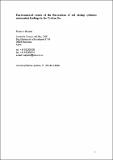Por favor, use este identificador para citar o enlazar a este item:
http://hdl.handle.net/10261/17025COMPARTIR / EXPORTAR:
 SHARE SHARE
 CORE
BASE CORE
BASE
|
|
| Visualizar otros formatos: MARC | Dublin Core | RDF | ORE | MODS | METS | DIDL | DATACITE | |

| Título: | Environmental causes of the fluctuations of red shrimp (Aristeus antennatus) landings in the Catalan Sea |
Autor: | Maynou, Francesc CSIC ORCID | Palabras clave: | Aristeus antennatus Fisheries NW Mediterranean North Atlantic Oscillation |
Fecha de publicación: | jun-2008 | Editor: | Elsevier | Citación: | Journal of Marine Systems 71(3-4): 294-302 (2008) | Resumen: | The fluctuations of catches of the deep-sea shrimp Aristeus antennatus (Risso, 1816) were analysed in the 6 ports of Catalonia where production is concentrated, based on monthly landings from 1988 to 2004. The 6 selected ports produced 300 t of red shrimp in 2004, or 80% of the total production in Catalonia. The series for each port showed clear interannual variability, with peaks of production in the early 1990s and more recently from 2001 to 2003. The time periods of the monthly data series, estimated by frequency analysis based on Fourier transform, varied around 7–8 years in the four central ports and 12–13 years in the two northern ports. Additionally, the different curves were not in phase: even in nearby ports, the maximum production is observed in different years. Since the North Atlantic Oscillation (NAO) index is an excellent proxy for long-term series of environmental variables, we aimed to explore relationships between the fluctuation of the NAO index and A. antennatus landings in the Catalan Sea. The correlation between the mean annual NAO index and the annual catches in each port was positive and significant with some time lags (from 1 to 3 years). The existence of clear patterns linking the NAO with marine ecological processes has been demonstrated in many studies, but the underlying ecological mechanisms are far from being well understood. The variations in environmental parameters linked to the NAO may act on biological organisms at different levels (individual, population) through physiology (metabolic and reproductive processes) or through trophic relationships, including ecological cascade effects. We propose that NAO-induced environmental variability may enhance food supply to A. antennatus and hence strengthen the reproductive potential of particular year classes, which result in increased catches 1 to 3 years later, although other possible effects of environmental variability on the population dynamics of this species are worth investigating | Descripción: | 9 pages, 3 figures, 1 table.-- Available online Nov 9, 2007.-- Issue title: "The Wrapping Up of the IDEA Project: International workshop on environment, demersal resources and fisheries" (Enric Massutí, Joan Moranta, John D.M. Gordon, Beatriz Morales-Nin and Pere Oliver, eds) | Versión del editor: | https://doi.org/10.1016/j.jmarsys.2006.09.008 | URI: | http://hdl.handle.net/10261/17025 | DOI: | 10.1016/j.jmarsys.2006.09.008 | ISSN: | 0924-7963 |
| Aparece en las colecciones: | (ICM) Artículos |
Ficheros en este ítem:
| Fichero | Descripción | Tamaño | Formato | |
|---|---|---|---|---|
| Maynou_2008.pdf | 333,38 kB | Adobe PDF |  Visualizar/Abrir |
CORE Recommender
SCOPUSTM
Citations
48
checked on 11-abr-2024
WEB OF SCIENCETM
Citations
47
checked on 29-feb-2024
Page view(s)
329
checked on 18-abr-2024
Download(s)
247
checked on 18-abr-2024
Google ScholarTM
Check
Altmetric
Altmetric
NOTA: Los ítems de Digital.CSIC están protegidos por copyright, con todos los derechos reservados, a menos que se indique lo contrario.
